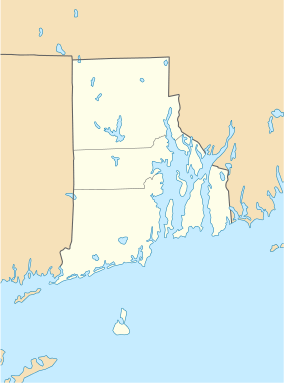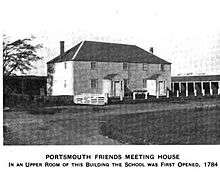Moses Brown School
| Moses Brown | |
|---|---|
|
| |
|
Original building of the Moses Brown School campus, ca.1819 | |
| Location | |
|
Providence, Rhode Island United States | |
| Coordinates |
41°49′59.2″N 71°23′54.36″W / 41.833111°N 71.3984333°WCoordinates: 41°49′59.2″N 71°23′54.36″W / 41.833111°N 71.3984333°W View on Google Maps |
| Information | |
| Type | Private |
| Religious affiliation(s) | Quaker |
| Established | 1784 |
| Head of school | Matt Glendinning |
| Faculty | 216 |
| Enrollment | 771 total |
| Average class size | 11 to 15 students |
| Student to teacher ratio | 8:1 |
| Campus | Urban, 33 acres (130,000 m2) |
| Color(s) | White and Navy Blue |
| Athletics | 30 sports |
| Mascot | Quaker |
| Average SAT scores | Math - 750, Writing - 780, Reading - 720 |
| Website | |
|
Moses Brown School | |
  | |
| Location |
250 Lloyd Avenue Providence, Rhode Island |
| Area | 30 acres (12 ha) |
| Built | 1819 |
| Architect | Greene, John Holden; Brown, Joseph |
| Architectural style | Colonial Revival, Second Empire |
| NRHP Reference # | 80000088[1] |
| Added to NRHP | July 24, 1980 |
The Moses Brown School is a Quaker school located in Providence, Rhode Island, United States. The school was founded in 1784 by Moses Brown, a Quaker abolitionist. It is one of the oldest preparatory schools in the United States.[2] The school motto is “For the Honor of Truth” and the school song is "Beneath the Elms" a reference to the large grove of elm trees that still surrounds the school to this day.[3]
Founder
Moses Brown (1738–1836) was a member of the Brown family, a powerful mercantile family of New England, a co-founder of Brown University, and a New England abolitionist and industrialist. He went on to become a pioneering advocate of abolition of slavery in the United States while starting the Moses Brown School.
History

In 1777 a committee of New England Yearly Meeting took up the idea for a school to educate young Quakers in New England. The committee, which included Moses Brown, was part of an effort within Quakerdom to promote their faith to the next generation. Brown wanted to ensure that when they reached adulthood they would be able to make a living.
The school opened in 1784 at Portsmouth Friends Meeting House in Portsmouth on Aquidneck Island, which was the administrative center for Yearly Meeting, and which had historically been heavily Quaker. However, by the 1780s it was an isolated location, and in the years after the American Revolution it was difficult to recruit both students and teachers. Four years later the Yearly Meeting decided to close the school "for one year" in June 1788; the school remained closed for over three decades.[4]
During those years, Moses Brown worked to restart the school, and, as treasurer of the school fund, was able to convince the Yearly Meeting to reopen the school – in part by donating a portion of his farm located in Providence for the school to be built on.
The school reopened in 1819 in Providence under the name "The New England Yearly Meeting Boarding School." Moses Brown then joined with his son Obadiah and his son-in-law William Almy to pay for the construction of the first building, which still serves as the main building of the school. Obadiah Brown also left $100,000 (equivalent to $1.55 million in 2015) in his will to the school, a sum unheard of at the time for a school endowment or gift. In 1904 the school was renamed "Moses Brown School" to honor its benefactor and advocate. It offered an "upper" and "lower" school for "younger boys".[5]
As the Quakers were early advocates of gender equality, Moses Brown School was a co-educational school. However, in 1926 it became a boys-only school as was the fashion in U.S. society at the time. As attitudes again became more liberal, it again became coed in 1976. Well-known faculty over the years included the twin Quaker educators Alfred and Albert Smiley in the mid-Nineteenth Century[6] and noted children's author Scott Corbett in the 1960s. "Moses Brown School: A History of its Third Half-Century" by Bill Paxton, covers the school's history during the period 1919-1969.[7]
As of 2013 the school was owned by New England Yearly Meeting, with its own Board of Overseers, and operated independently of the yearly meeting. The school was examining the possibility of changing its specific affiliation while still retaining its identity as a Quaker school.
Academics
Ninth and tenth graders are offered limited flexibility in their courses, aiming to expose them to a varied selection of topics. Juniors and Seniors, however, are much freer to flexibly select electives and other such courses. English is the only subject mandated through four years in the Upper School. Students must complete at least rrecalculus in order to satisfy their mathematics requirement, study a single language for three years, and lab sciences for two. There is a requirement for a comparative religions class. Students are also required to take a minimum of two semesters of fine art classes. In addition the cornerstone Co-Curricular program remains a of the Moses Brown experience. Students are required to participate in varied school activities whether athletic, theater, dance, or community service.[3]
Facilities
- 33 acres (130,000 m2) on Providence's East Side
- Collis Science Center- Upper School science complex on the ground floor of Friends Hall. These facilities provide two lab/classrooms each for biology, physics, and chemistry, lab prep rooms, a faculty resource room, and smart boards, wireless tablets, and Internet access.
- Dwares Family Student Center- Provides upper school students with areas for quiet study, student leadership meetings, clubs, activities, and informal gatherings with friends and faculty.
- Krause Gallery- Exhibiting works of artists in residence and visiting artists.
- Hoffman House and Lubrano Science Classroom- These middle school facilities house three science labs, classrooms, breakout spaces, meeting areas, and faculty/advisor offices.
- Fischer Ricci Family Instrumental Music Center- Provides ensemble room and practice suites.
- Waughtel-Howe Field House- indoor track, basketball courts, Physical Therapy center, weight and training room, men's and women's locker rooms, coaches' offices, and the Athletic Hall of Fame.
- Campanella Field- Campanella Field was converted to a FieldTurf artificial turf field during the winter and spring of 2006 to 2007. This is the same FieldTurf that numerous professional teams play on. It is home to the Football, Field Hockey, Girls and Boys Lacrosse and Boys and Girls Soccer teams at both the Upper and Middle School level. The FieldTurf replaced AstroTurf which was first installed in 1965. Moses Brown was the first athletic facility in the United States to install AstroTurf.
- Milot Field- Athletic fields belonging to Moses Brown School in Rehoboth, Massachusetts
- Woodman Center - Moses Brown will be creating a new facility for the performing arts to replace the outdated space in Alumni Hall. The new space will be state of the art with a green room and space to seat the entire student body. It will be connected to the current library by a sky bridge that will contain study spaces. The center will have new community spaces including an outdoor cafe.
Notable alumni
- David Aldrich, artist and architect[8]
- Steven G. Calabresi, co-founder of The Federalist Society
- Thomas M. Chappell, co-founder of Tom's of Maine
- Buddy Cianci, former mayor of Providence Rhode Island.[9]
- Halsey Chase Herreshoff, naval architect
- Christopher R. Hill, diplomat, U.S. Ambassador to Iraq
- Leo Laporte, American technology broadcaster, author, and entrepreneur
- Chris Rotelli, lacrosse player, 3x All-American at the University of Virginia, 2003 Tewaaraton Trophy winner, top pick in 2003 Major League Lacrosse draft, 2x MLL All-Star, national champion for UVA.
- Frank Sulloway, American psychologist and author
- Paul A. Suttell, Chief Justice, Rhode Island Supreme Court
- Dean Woodman, American businessman and co-founder of the investment bank Robertson Stephens[10]
- Jesse Williams, American actor and activist
See also
- National Register of Historic Places listings in Providence, Rhode Island
- List of high schools in Rhode Island
References
- ↑ National Park Service (2010-07-09). "National Register Information System". National Register of Historic Places. National Park Service.
- ↑ "History". mosesbrown.org. Moses Brown School. Archived from the original on 2 Nov 2005. Retrieved 28 Nov 2016 – via web.archive.org.
- 1 2 "MB at-a-glance". mosesbrown.org. Moses Brown School. Retrieved 29 Nov 2016.
- ↑ Kelsey, Rayner Wickersham (1919). Centennial history of Moses Brown school, 1819-1919. Moses Brown School. p. 50. Retrieved 29 Nov 2016.
- ↑ "Moses Brown School". The Independent. New York City. 6 Jul 1914. Retrieved 29 Nov 2016.
- ↑ Tyler, Betty (21 Mar 2009). "Smiley twins: the early years". Redlands Daily Facts. Redlands, California: Digital First Media. Retrieved 29 Nov 2016.
- ↑ "Moses Brown School;: A history of its third half-century, 1919-1969". amazon.com. Retrieved 29 Nov 2016.
- ↑ "A History of Swan Point Cemetery". lahistoryarchive.org. Swan Point Cemetery. Retrieved 26 Mar 2014.
- ↑ Vincent "Buddy Cianci", Jr., David Fisher, Politics and Pasta: How I Prosecuted Mobsters, Rebuilt a Dying City, Dined with Sinatra, Spent Five Years in a Federally Funded Gated Community, and Lived to Tell the Tale pg. 10
- ↑ Moses Brown School: "More than two thousand members of the MB community were on campus Oct. 17-19 for MB Expo, a celebration of play, passion and purpose" retrieved May 26, 2014
External links
| Wikimedia Commons has media related to Moses Brown School. |
- Historic American Buildings Survey (HABS) No. RI-255, "Friends' School, 257 Hope Street, Providence, Providence County, RI", 1 photo, 3 data pages, supplemental material
- GreatSchools
